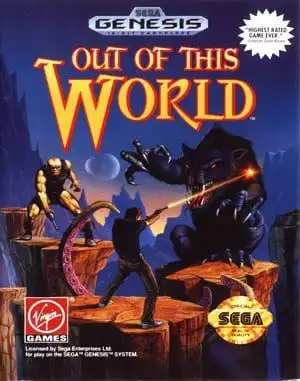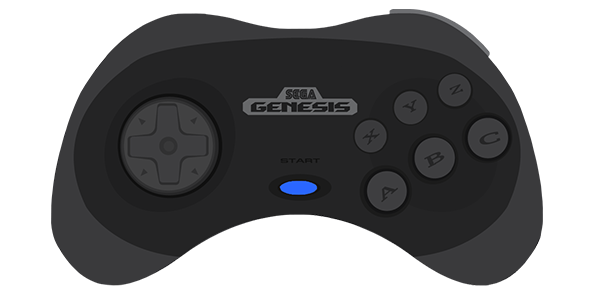Remember that feeling? Booting up your Sega Genesis, the familiar "SEGA" chime, and then... silence. Eerie, atmospheric silence, punctuated by the hum of a particle accelerator gone wrong. That's the unforgettable start of Out of This World on the Sega Genesis, a game that defied convention and left an indelible mark on a generation of gamers.
Known as Another World outside of North America, this title wasn't your typical run-and-gun or platforming mascot fare. It was a cinematic experience, a puzzle-platformer wrapped in a minimalist sci-fi narrative that threw you into the deep end without a life raft. And experiencing Out of This World on Sega Genesis was, for many, their first encounter with this groundbreaking design.
What Made "Out of This World" So... Out of This World?
Forget health bars, score counters, or chatty companions. Out of This World stripped away all the usual gaming crutches. You were Lester Knight Chaykin, a physicist zapped to a hostile alien planet, and survival was your only goal.
Key elements that set it apart:
- Cinematic Presentation: Using vector-like polygon graphics (though rendered as bitmaps on Genesis), the game felt like an animated movie. Cutscenes blended seamlessly into gameplay.
- No HUD, No Dialogue: The story unfolded purely through visuals and actions. You had to observe, learn, and react. The alien language was just that – alien.
- Atmosphere: A sense of isolation, danger, and wonder permeated every screen, amplified by a sparse, effective soundtrack.
- Instant Death: Tripping a laser, getting shot, falling too far – most mistakes meant instant death. This sounds harsh, but coupled with frequent checkpoints, it turned every encounter into a tense puzzle.
Stranded on an Alien World: The Story Unfolds
The plot is simple yet effective: Lester's experiment goes wrong, and he's teleported to a strange, dangerous planet. Almost immediately, he's captured by humanoid aliens. His escape is aided by an unlikely ally, another captive alien who quickly becomes known to players as "Buddy."
The core of the game is the journey of Lester and Buddy as they navigate this hostile world, evading enemies, solving environmental puzzles, and building a bond through shared peril. It's a story told through action and reaction, a testament to visual storytelling in the 16-bit era.
Gameplay on the Genesis: Survival Through Observation
Playing Out of This World on Sega Genesis required patience and quick reflexes. Lester's moves were limited initially: walk, run, jump, and a surprisingly effective kick. Soon, you acquire a laser pistol, not just for shooting, but also for creating force fields and charging up powerful shots to break through barriers.
The gameplay was a mix of:
- Platforming: Navigating tricky jumps and environmental hazards.
- Puzzles: Figuring out how to bypass obstacles using your environment or laser pistol.
- Combat: Tense, often one-on-one encounters where timing your shots or force fields was crucial.
Every screen was a challenge, requiring you to observe enemy patterns, environmental clues, and the consequences of your actions. It was trial and error, yes, but in a way that felt rewarding when you finally figured out the solution.
How Did the Genesis Port Stack Up?
The Sega Genesis version of Out of This World was generally well-received. While perhaps not as visually sharp as the Amiga original or the later SNES port, it captured the essence of the game remarkably well. The distinctive character animations, the minimalist backgrounds, and the overall atmosphere translated effectively to Sega's 16-bit hardware.
Sound design was crucial to the game's mood, and the Genesis port delivered the key atmospheric cues and sound effects, even if the music varied slightly from other versions. For many Genesis owners, this was the definitive way to experience this unique title.
Why It Still Resonates Today
Out of This World's influence can be seen in countless games that prioritize atmosphere, minimalist storytelling, and challenging environmental puzzles. Its bold design choices were ahead of their time and still feel fresh today.
Reliving the Out of This World Sega Genesis experience brings back memories of a time when games dared to be different, pushing the boundaries of what was possible with limited hardware to create something truly artistic and memorable.
If you want to revisit this classic, enhanced versions are available on platforms like GOG.com, making it accessible on modern PCs. For the purists, exploring emulation (like Genesis Plus GX within RetroArch) can offer a way to experience the game exactly as it was on the original hardware, complete with that slightly darker Genesis palette and unique sound chip. Sites like Archive.org sometimes host playable versions or historical data, too.
Frequently Asked Questions
Q: Is Out of This World really that hard? A: Yes, its instant death mechanic makes it challenging, requiring careful observation and trial-and-error. However, frequent checkpoints make it manageable.
Q: What is the alien companion's name? A: He's commonly referred to by players as "Buddy," though he has no official name within the game itself.
Q: Is the Sega Genesis version the best one? A: It's subjective! Many grew up with and love the Genesis port. Other versions (Amiga, SNES, PC) have slight differences in graphics, sound, or color palettes. The modern "20th Anniversary" or "30th Anniversary" editions offer enhancements but stay true to the original.
Q: Can I play Out of This World on modern systems? A: Absolutely! Enhanced versions are available digitally on PC (GOG, Steam), consoles, and mobile. You can also explore emulating the original Genesis ROM.
A Timeless Journey on 16 Bits
Out of This World on Sega Genesis remains a standout title in the console's library. It was a bold, artistic statement that proved video games could be more than just high scores and power-ups. It was a journey, a struggle for survival, and a testament to the power of visual storytelling. Booting it up today is more than just playing a game; it's stepping back into a piece of interactive cinema that still holds up, challenging and captivating players just as it did decades ago.


